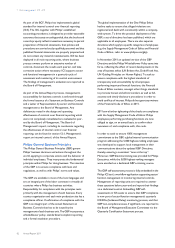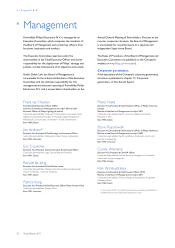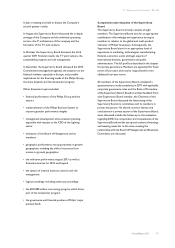Philips 2011 Annual Report Download - page 90
Download and view the complete annual report
Please find page 90 of the 2011 Philips annual report below. You can navigate through the pages in the report by either clicking on the pages listed below, or by using the keyword search tool below to find specific information within the annual report.7 Risk management 7.6 - 7.6
90 Annual Report 2011
7.6 Financial risks
Philips is exposed to a variety of treasury risks including
liquidity risk, currency risk, interest rate risk, commodity
price risk, credit risk, country risk and other insurable
risk.
Negative developments impacting the global liquidity
markets could affect the ability to raise or re-finance debt
in the capital markets or could lead to significant increases
in the cost of such borrowing in the future. If the market
expect a downgrade or downgrades by the rating agencies
or if such a downgrade has actually taken place, it could
increase our cost of borrowing, reduce our potential
investor base and adversely affect our business.
Philips is exposed to fluctuations in exchange rates,
especially between the US dollar and the euro. A high
percentage of its business volume is conducted in the US
but based on exports from Europe, whilst, a considerable
amount of US dollar - denominated imports is also sold in
Europe. In addition, Philips is exposed to currency effects
involving the currencies of growth geographies such as
China, India and Brazil.
Philips is also exposed to interest rate risk, particularly in
relation to its long-term debt position; this risk can take
the form of either fair value or cash flow risk. Failure to
effectively hedge this risk can impact Philips’ financial
condition and operating results.
Philips’ supply chain is also exposed to fluctuations in
energy and raw material prices. In recent times,
commodities such as oil have been subject to volatile
markets and significant price increases from time to time.
If Philips is not able to compensate for, or pass on, its
increased costs to customers, such price increases could
have an adverse impact on its financial condition and
operating results.
The credit risk of financial and non-financial
counterparties with outstanding payment obligations
creates exposure for Philips, particularly in relation to
accounts receivable and liquid assets and fair values of
derivatives and insurance contracts with financial
counterparties. A default by counterparties in such
transactions can have a material adverse effect on Philips’
financial condition and operating results.
For further analysis, please refer to note 34, Details of
treasury risks.
Corporate Control, together with Sector and Functional
management, performs an assessment of financial
reporting risks at least annually.
A risk rating is assigned for each risk identified, based on
the likelihood of occurrence and the potential impact of
the risk on the financial statements and related
disclosures. In determining the probability that a risk will
result in a misstatement of a more than inconsequential
amount or material nature, the following factors are
considered to be critical: complexity of the associated
accounting activity or transaction process, history of
accounting and reporting errors, likelihood of significant
(contingent) liabilities arising from activities, exposure to
losses, existence of a related party transaction, volume of
activity and homogeneity of the individual transactions
processed and changes to the prior period in accounting
characteristics compared to the previous period.
Important critical reporting risk areas identified within
Philips following the risk assessment are:
• complex accounting for sales-related accruals, warranty
provisions, tax assets and liabilities, pension benefits,
and business combinations
• complex sales transactions relating to multi-element
deliveries (combination of goods and services)
• valuation procedures with respect to assets (including
goodwill and inventories)
• past experience of control failures relating to
segregation of duties
• significant (contingent) liabilities such as environmental
claims and other litigation
• outsourcing of high volume/homogeneous
transactional finance and IT operations to third-party
service providers
Processes and controls related to the identified critical
risk areas will be subject to a more detailed set of
requirements in terms of control documentation and
control evaluation (monitoring) by Sector and Functional
management due to their importance for the reliability of
the financial statements and disclosures of the Group.
Philips is exposed to a number of different fiscal
uncertainties which could have a significant impact on
local tax results.
Philips is exposed to a number of different tax
uncertainties which could result in double taxation,
penalties and interest payments. These include transfer
pricing uncertainties on internal cross-border deliveries
of goods and services, tax uncertainties related to
acquisitions and divestments, tax uncertainties related to
the use of tax credits and permanent establishments, tax
uncertainties due to losses carried forward and tax credits
























